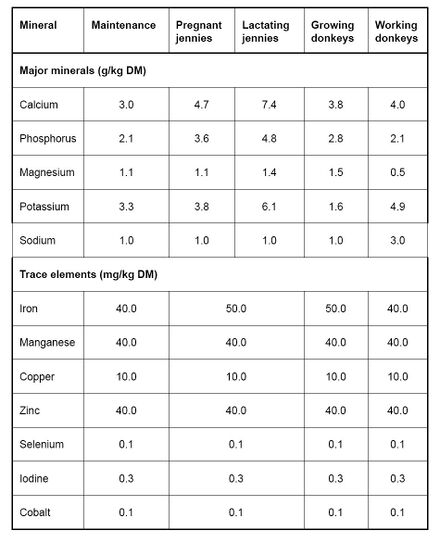Mineral Requirements - Donkey -

Minerals are a range of inorganic nutrients that play a wide role in the donkey’s body. They are classified into two groups:
- Macro (or major) minerals that are required in relatively large quantities (several grams per day). These include the elements calcium, phosphorus, sodium, chlorine, potassium and magnesium
- Trace (or minor) minerals are required in relatively small amounts (milligrams per day). These include the elements copper, iron, zinc, selenium, and iodine
Calcium and phosphorus are major constituents of bone, and both minerals have a major metabolic role. Bones act as a reservoir of calcium and phosphorus when dietary levels of the elements are low. If these deficiencies are prolonged, the bones can become weakened. In young donkeys lack of calcium and phosphorus can result in developmental orthopaedic disease resulting in permanent bone deformity and weakness.
Excessive dietary phosphorus can interfere with the absorption of calcium. Levels of phosphorus relative to calcium are particularly high in some by-products such as bran and cotton seed that are commonly fed to working donkeys in developing countries. Keepers should attempt to provide mineral licks wherever possible to prevent imbalance and deficiencies in calcium and phosphorus.
Sodium and chloride ions are lost in sweat to a greater extent than other minerals. Consequently, demands for sodium chloride are higher in working donkeys in hot environments. Care should be taken to offer working animals salt to allow them to make up for these perspiration losses. It is better to supply salt licks separately to other food, because high salt content in food tends to suppress appetite, resulting in a reduction in total nutrient intake.
References
- Smith, D. and Wood, S. (2008) Donkey nutrition In Svendsen, E.D., Duncan, J. and Hadrill, D. (2008) The Professional Handbook of the Donkey, 4th edition, Whittet Books, Chapter 1
- McDonald, P., Edward, R.A., Greenhalgh, J.F.D., and Morgan, C.A. (2002). Animal Nutrition (6th Edition). Prentice Hall, Harrow.
|
|
This section was sponsored and content provided by THE DONKEY SANCTUARY |
|---|